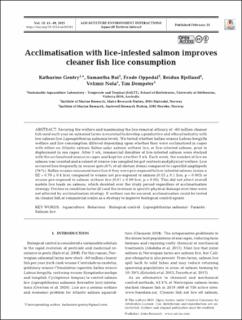| dc.contributor.author | Gentry, Katherine | |
| dc.contributor.author | Bui, Samantha | |
| dc.contributor.author | Oppedal, Frode | |
| dc.contributor.author | Bjelland, Reidun Marie | |
| dc.contributor.author | Nola, Velimir | |
| dc.contributor.author | Dempster, Timothy David | |
| dc.date.accessioned | 2022-03-09T11:35:34Z | |
| dc.date.available | 2022-03-09T11:35:34Z | |
| dc.date.created | 2022-02-11T14:58:55Z | |
| dc.date.issued | 2021 | |
| dc.identifier.citation | Aquaculture Environment Interactions. 2021, 13 41-49. | en_US |
| dc.identifier.issn | 1869-215X | |
| dc.identifier.uri | https://hdl.handle.net/11250/2983983 | |
| dc.description.abstract | Securing the welfare and maximising the lice removal efficacy of ~60 million cleaner fish used each year on salmonid farms is essential to develop a productive and ethical industry with low salmon lice Lepeophtheirus salmonis levels. We tested whether ballan wrasse Labrus bergylta welfare and lice consumption differed depending upon whether they were acclimatised in cages with either no Atlantic salmon Salmo salar, salmon without lice, or lice-infested salmon, prior to deployment in sea cages. After 1 wk, commercial densities of lice-infested salmon were stocked with the acclimatised wrasse in cages and kept for a further 3 wk. Each week, the number of lice on salmon was counted and a subset of wrasse was sampled for gut contents and physical welfare. Lice occurred less frequently in wrasse guts (6% of all dietary items) compared to caprellid amphipods (76%). Ballan wrasse consumed more lice if they were pre-exposed to lice-infested salmon (mean ± SE = 0.79 ± 0.4 lice) compared to wrasse not pre-exposed to salmon (0.15 ± 0.1 lice, p = 0.003) or wrasse pre-exposed to salmon without lice (0.01 ± 0.09 lice, p = 0.03). This did not affect overall mobile lice loads on salmon, which doubled over the study period regardless of acclimatisation strategy. Decline in condition factor (K) and the increase in specific physical damage over time were not affected by acclimatisation strategy. If welfare can be secured, acclimatisation could be tested on cleaner fish at commercial scales as a strategy to improve biological control agents. | en_US |
| dc.language.iso | eng | en_US |
| dc.title | Acclimation with lice-infested salmon improves cleaner fish delousing performance | en_US |
| dc.type | Peer reviewed | en_US |
| dc.type | Journal article | en_US |
| dc.description.version | publishedVersion | en_US |
| dc.source.pagenumber | 41-49 | en_US |
| dc.source.volume | 13 | en_US |
| dc.source.journal | Aquaculture Environment Interactions | en_US |
| dc.identifier.doi | 10.3354/aei00385 | |
| dc.identifier.cristin | 2000605 | |
| dc.relation.project | Norges forskningsråd: 267800 | en_US |
| dc.relation.project | Havforskningsinstituttet: 14597 | en_US |
| cristin.ispublished | true | |
| cristin.fulltext | original | |
| cristin.qualitycode | 1 | |
